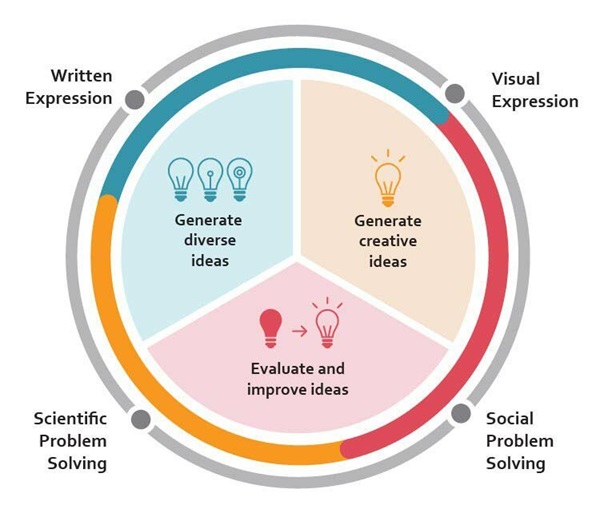Creativity in learning enriches wellbeing

Creative thinking was assessed as a competence for the first time in PISA 2022, emphasising a new understanding of its importance in a well-rounded education. The study defined it as the ability to engage productively in the generation, evaluation and improvement of ideas.
The third PISA 2022 report will focus on this creative thinking assessment. It will examine pupils’ capacity to generate original and diverse ideas, and how attitudes towards creative thinking vary in different countries and educational contexts.
Source:PISA Creative Thinking Test by OECD
Creative pedagogical approaches using the arts
Integrating music, visual arts, drama and dance into the general curriculum nurtures pupils’ creative thinking ability. Creative expression through the arts enhances cognitive development and serves as a form of self-expression and stress relief.
The Colors project took a cognitive approach, using tests to identify different kinds of intelligence and align them with creative learning techniques. These included:
- music classes and rhythm workshops for pupils for rhythmic intelligence
- painting workshops and design workshops for visual intelligence
- composition and poetry contests for verbal intelligence.
Connecting pupils to learning using creativity
Some pupils have specific needs because of their personal circumstances, and encouraging their creativity can help them feel connected. Young people who feel disconnected from their school or peers have a higher risk of substance and mental health problems, and early school leaving.
- The To be or not be well? project used drama and theatre to develop methods to support pupil wellbeing and help them feel connected and engaged with their communities and peers.
- The CHIMES project using music and dance as a vehicle for engagement with disadvantaged young people who feel excluded, whether socially, economically or for cultural, personal or mental health reasons, to help these young people to feel engaged in society and learning.
- The Once upon YOUR time project used the study of national tales and myths as an innovative method to work with young people at risk of school dropout and social exclusion to prevent, solve and understand disruptive, antisocial or exclusionary attitudes.
- The ALIISA Project aimed to development inclusive art pedagogy in international cooperation between higher education and general art education.
- The Digital Director project used training in film skills to enable pupils to create short films about social, political or psychological problems that affect them.
Creative learning environments: space for exploration
The opportunity for play, experimentation and exploration creates an atmosphere in which children are secure enough to take risks and make mistakes.
Flexible learning environments, with adaptable seating arrangements, movable furniture and designated creative spaces can support a variety of learning styles and encourage collaboration and invention.
Nature-based activities not only stimulate creativity but also promote physical and emotional wellbeing. Teachers can take learning outside the classroom with outdoor education experiences.
The Opening the door to outdoor project used ideas and topics specific to each participant country to take learning outside.
- Iceland: volcanoes, geysers and glaciers
- Germany: mathematics and the environment
- Netherlands: farm and outdoor arts activities
- Croatia: biology in underground caves and seasides
- Greece: history and democracy
The goal of the Green extended classroom project was to provide space for innovative, creative forms of learning about sustainability and health in an outdoor setting.
Thematic collections of practical and digital learning material were created to help pupils get to know their environment through artistic interpretation and creative sustainability projects, including a cross-school competition to build new class mascots from recycled materials.
A role for teachers’ own creativity
Teachers can use their own creativity to encourage interdisciplinary learning and connect different subject areas in classroom projects. This promotes creativity by encouraging pupils to create new ideas and understand what they are learning in a larger context.
- Incorporating regular opportunities for reflection and feedback into the learning process encourages pupils to reflect on their creative processes, celebrate their successes and learn from challenges.
- Providing pupils with opportunities for choice and autonomy in their learning fosters a sense of engagement and ownership and empowers them to explore their creativity.
Additional information
-
Target audience:TeacherStudent TeacherHead Teacher / PrincipalTeacher EducatorResearcher
-
Target audience ISCED:Primary education (ISCED 1)Lower secondary education (ISCED 2)Upper secondary education (ISCED 3)

